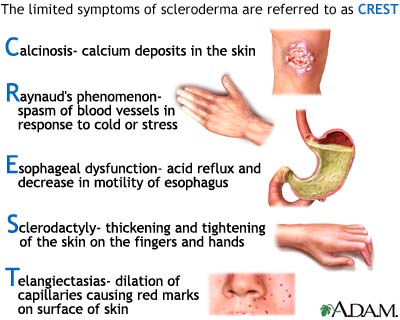CREST syndrome

The symptoms involved in CREST syndrome are associated with the generalized form of the disease Systemic sclerosis (scleroderma). CREST is an acronym for the clinical features that are seen in a patient with this disease. The “C” stands for calcinosis, where calcium deposits form under the skin on the fingers or other areas of the body. The “R”, stands for Raynaud’s phenomenon, spasm of blood vessels in the fingers or toes in response to cold or stress. The “E” represents esophageal dysmotility, which can cause difficulty in swallowing. The “S” is for sclerodactyly, tightening of the skin causing the fingers to bend. Finally, the letter “T” is for telangiectasia, dilated vessels on the skin of the fingers, face, or inside of the mouth.
Usually only 2 of the five symptoms of the CREST syndrome is necessary to be diagnosed with the disease.
Update Date: 2/2/2012
Updated by: Ariel D. Teitel, MD, MBA, Clinical Associate Professor of Medicine, NYU Langone Medical Center. Review provided by VeriMed Healthcare Network. Also reviewed by David Zieve, MD, MHA, Medical Director, A.D.A.M., Inc.
Notice: The information provided herein should not be used during any medical emergency or for the diagnosis or treatment of any medical condition. A licensed physician should be consulted for diagnosis and treatment of any and all medical conditions. Call 911 for all medical emergencies. Links to other sites are provided for information only -- they do not constitute endorsements of those other sites. Copyright 1997-2012, A.D.A.M., Inc. Any duplication or distribution of the information contained herein is strictly prohibited.
